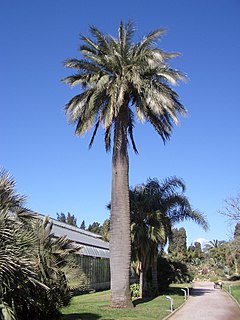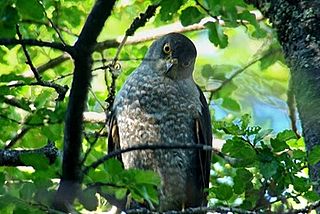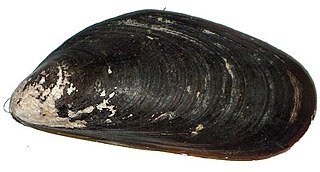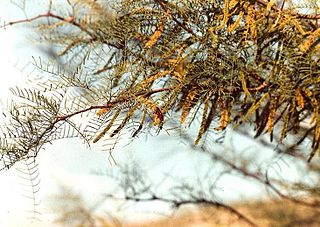Related Research Articles

The southern lapwing is a wader in the order Charadriiformes. It is a common and widespread resident throughout South America, except in densely forested regions, the higher parts of the Andes and the arid coast of a large part of western South America. This bird is particularly common in the basin of the Rio de la Plata. It has also been spreading through Central America in recent years. It reached Trinidad in 1961 and Tobago in 1974, and has rapidly increased on both islands, sporadically making its way North to Barbados where one pair mated, nested and produced chicks in 2007.

Austrocedrus is a genus of conifer belonging to the cypress family (Cupressaceae). It has only one species, Austrocedrus chilensis, native to the Valdivian temperate rain forests and the adjacent drier steppe-forests of central-southern Chile and western Argentina from 33°S to 44°S latitude. It is known in its native area as ciprés de la cordillera or cordilleran cypress, and elsewhere by the scientific name as Austrocedrus, or sometimes as Chilean incense-cedar or Chilean cedar. The generic name means "southern cedar".

The Chilean skua, also called the cinnamon skua, is a large predatory seabird, which breeds in Argentina and Chile, but ranges as far north as Brazil and Peru when not breeding. A relatively distinctive skua, it has a dark cap that contrasts with its cinnamon throat and lower face. Hybrids with the brown skua are known from southern Argentina.

Jubaea is a genus of palms with one species, Jubaea chilensis or Jubaea spectabilis, commonly known in English as the Chilean wine palm or Chile cocopalm, and palma chilena in Spanish. It is native to southwestern South America and is endemic to a small area of central Chile between 32°S and 35°S in southern Coquimbo, Valparaíso, Santiago, O'Higgins, and northern Maule regions.

The redspotted catshark, also known as the Chilean catshark, is a species of catshark commonly found in the coastal waters of the southeastern Pacific, from central Peru to southern Chile. They are typically found in the rocky sublittoral areas at the edge of the continental shelf, in waters down to 100 m in depth. They spend the spring, summer, and fall in rocky subtidal areas, but winter in deeper offshore waters due to the strong currents at that time of year.

The paradise tanager is a brilliantly multicolored, medium-sized songbird whose length varies between 13.5 and 15 cm. It has a light green head, sky blue underparts and black upper body plumage. Depending on subspecies, the behind is yellow and red or all red. The beak is black and the legs are grey. it is from the amazon rainforest.

La Campana National Park is located in the Cordillera de la Costa, Quillota Province, in the Valparaíso Region of Chile. La Campana National Park and the Vizcachas Mountains lie northwest of Santiago. This national park covers approximately 80 square kilometres (31 sq mi) and is home to one of the last palm forests of Jubaea chilensis, which prehistorically had a much wider distribution than at present. Another attraction is the Cerro La Campana, which lends its name to the park. In 1834 Charles Darwin climbed this mountain, during the second voyage of HMS Beagle.

The Chilean tinamou is a type of tinamou commonly found in high altitude shrubland in subtropical regions of central Chile.

Maytenus boaria (mayten) is an evergreen tree of the family Celastraceae, native from South America, up to 20 m (66 ft), 80 cm (31 in) diameter, straight trunk. It occurs naturally approximately from 30 to 50ºS: Chile and Argentina.

The Chilean hawk is a bird of prey species belonging to the typical hawks. It breeds in Andes forests from central Chile and western Argentina south to Tierra del Fuego, from sea level to 2,700 m altitude. Some winter apparently in the lowlands of NW Argentina.

The Chilean mussel or Chilean blue mussel is a species of blue mussel native to the coasts of Chile, Argentina, Uruguay, the Falkland Islands and the Kerguelen islands. In the scientific literature, it has also been referred to as Southern Mytilus edulis, or Mytilus edulis platensis, or Mytilus chilensis.

Miel de palma is an edible sweet syrup produced from the sap of a number of palms. It is produced in the Canary Islands and coastal regions of South America.

The dredge oyster, bluff oyster or Chilean oyster: Ostrea chilensis, is also known in Chile as ostra verde.
Evocoa is a monotypic genus of flies containing the single species Evocoa chilensis. It is the only genus in the family Evocoidae.

The Chaco tortoise, also known commonly as the Argentine tortoise, the Patagonian tortoise, or the southern wood tortoise, is a species of tortoise in the family Testudinidae. The species is endemic to South America.

Pyura chilensis, called piure in Spanish, is a tunicate of the family Pyuridae. It was described in 1782 by Juan Ignacio Molina.

Ceroglossus chilensis, the Chilean magnificent beetle, is a species of beetle of the family Carabidae.

Salix humboldtiana, called Humboldt's willow, is a tree species of willow native to North and South America, growing along watercourses. Some authorities consider it a synonym of Salix chilensis, which Molina described in 1782. Willdenow described Salix humboldtiana in 1805.

Prosopis chilensis is a species of tree in the genus Prosopis, belonging to the family Fabaceae. It is found in parts of central Chile, southern Peru, Bolivia, and Andean (northwestern) Argentina. Its common names include Chilean mesquite, cupesí, and Chilean algarrobo. It is used for providing shade, for animal feed and for firewood.
Argyrochosma chilensis is a fern endemic to the Juan Fernández Islands off the coast of Chile. It has leathery, thrice-divided leaves with dark brown axes; the leaves are coated with white powder below. First described as a species in 1853, it was transferred to the new genus Argyrochosma in 1987, recognizing their distinctness from the "cloak ferns".
References
- ↑ "Coenochroa chilensis, a new Phycitine from Chile" (PDF). Archived from the original (PDF) on 2012-05-21. Retrieved 2011-12-19.